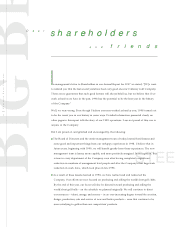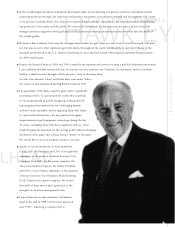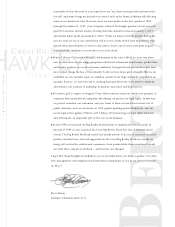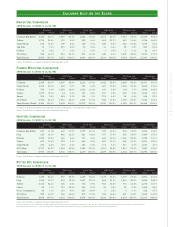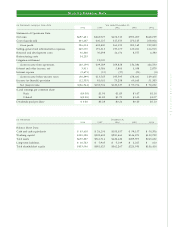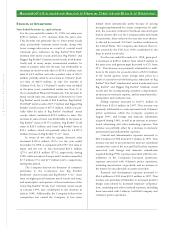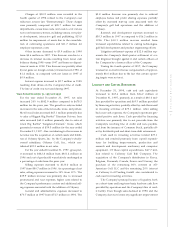Callaway 1998 Annual Report Download - page 14
Download and view the complete annual report
Please find page 14 of the 1998 Callaway annual report below. You can navigate through the pages in the report by either clicking on the pages listed below, or by using the keyword search tool below to find specific information within the annual report.
CALLAWAY GOLF COMPANY
12
have lower margins than metal woods. However, this
negative impact was offset by a shift in product sales mix
to a higher percentage of metal woods during the fourth
quarter of 1998. During 1999, the Company anticipates
its gross margin percentage to exceed its 1998 levels as a
result of a shift in product sales mix and decreased
inventory obsolescence and manufacturing labor and
overhead costs. However, consumer acceptance of cur-
rent and new product introductions as well as continu-
ing pricing pressure from competitive market conditions
may have an adverse effect on the Company’s future
sales and gross margin.
In the golf equipment industry, sales to retailers are
generally seasonal due to lower demand in the retail
market in the cold weather months covered by the
fourth and first quarters. The Company’s business gen-
erally follows this seasonal trend and the Company
expects this to continue. Unusual or severe weather con-
ditions such as the “El Niño” weather patterns experi-
enced during the winter of 1997-1998 may compound
these seasonal effects.
Competition
The market in which the Company does business is
highly competitive, and is served by a number of well-
established and well-financed companies with recog-
nized brand names, as well as new companies with pop-
ular products. New product introductions and/or price
reductions by competitors continue to generate
increased market competition and the Company
believes that such competition has caused it to lose some
unit market share and has negatively affected sales.
While the Company believes that its products and its
marketing efforts continue to be competitive, there can
be no assurance that successful marketing activities by
competitors will not negatively impact the Company’s
future sales.
A manufacturer’s ability to compete is in part
dependent upon its ability to satisfy the various subjec-
tive requirements of golfers, including the golf club’s
look and “feel,” and the level of acceptance that the golf
club has among professional and other golfers. The sub-
jective preferences of golf club purchasers also may be
subject to rapid and unanticipated changes. There can
be no assurance as to how long the Company’s golf clubs
will maintain market acceptance. For example, con-
sumer support for shallow-faced metal woods increased
in 1998, and many of the Company’s competitors are
making such products. The Company does not current-
ly make a “shallow-faced” wood, and does not believe
that the designs currently in the market are superior to
its deeper-faced offerings. However, if “shallow-faced”
products continue to gain consumer acceptance, the
Company’s sales could be negatively affected.
New Product Introduction
The Company believes that the introduction of new,
innovative golf equipment is increasingly important to
its future success. The Company faces certain risks asso-
ciated with such a strategy. For example, new models
and basic design changes in golf equipment are fre-
quently met with consumer rejection. In addition, prior
successful designs may be rendered obsolete within a rel-
atively short period of time as new products are intro-
duced into the marketplace. Further, new products that
retail at a lower price than prior products may negative-
ly impact the Company’s revenues unless unit sales
increase. New designs generally should satisfy the stan-
dards established by the United States Golf Association
(“USGA”) and the Royal and Ancient Golf Club of St.
Andrews (“R&A”) because these standards are generally
followed by golfers within their respective jurisdictions.
While all of the Company’s current products have been
found to conform to USGA and R&A rules, there is no
assurance that new designs will receive USGA and/or
R&A approval, or that existing USGA and/or R&A
standards will not be altered in ways that adversely affect
the sales of the Company’s products.
On November 2, 1998, the USGA announced the
adoption of a test protocol to measure the so-called
“spring-like effect” in certain golf clubheads. The USGA
has advised the Company that none of the Company’s
current products are barred by this test. The R&A is
considering the adoption of a similar or related test.
Future actions by the USGA or the R&A may impede
the Company’s ability to introduce new products and
therefore could have a material adverse effect on the
Company’s results of operations.
The Company’s new products have tended to incor-
porate significant innovations in design and manufac-
ture, which have resulted in higher prices for the
Company’s products relative to other products in the
marketplace. There can be no assurance that a signifi-
cant percentage of the public will always be willing to
pay such prices for golf equipment. Thus, although the
Company has achieved certain successes in the intro-
duction of its golf clubs in the past, no assurances can be
given that the Company will be able to continue to
design and manufacture golf clubs that achieve market
acceptance in the future.
The rapid introduction of new products by the
Company can result in closeouts of existing invento-
ries at both the wholesale and retail levels. Such close-
outs can result in reduced margins on the sale of older


